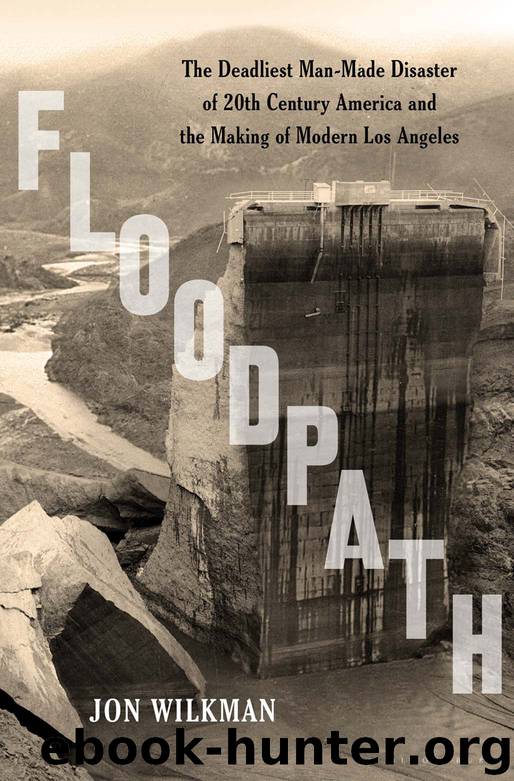Floodpath by Jon Wilkman

Author:Jon Wilkman [Wilkman, Jon]
Language: eng
Format: epub
ISBN: 9781620409169
Publisher: Bloomsbury Publishing
Published: 2015-11-09T16:00:00+00:00
10.
Los Angeles on Trial
Nine days after the St. Francis flood ebbed into the Pacific, accusations of a link between the disaster and a dynamite plot headlined newspapers and clashed with angry denials. In the midst of this furor, the Los Angeles County Coroner’s Inquest was just beginning. The Inquest wasn’t a criminal trial, but the hearing could lead to indictments—and perhaps a conviction for mass murder. The stakes were high for William Mulholland, the city of Los Angeles, and the future of dams in the United States and perhaps around the world.
Dams, reservoirs, and an aqueduct were critical to Mulholland’s 1920s survival and growth plan for Los Angeles, just as large-scale waterworks had been central to human civilization for more than six thousand years. Whatever the cause of the catastrophe that began in San Francisquito Canyon, to understand what happened, it was essential to know what should have kept the St. Francis Dam strong, as well as what could have brought it down.
Since the first dams in the ancient Middle East, engineers learned as much from failures as they did from successes—perhaps more. During millennia of trial, error, and applied computations, two approaches to dam design were developed: massive and structural. A massive dam depends on gravity and the barrier’s weight to resist hydrostatic pressure. A structural dam uses its shape. An arched dam is an example. When the weight of water presses against the upstream curve of the arch, the load is distributed to either side, pushing against the abutments to increase the structure’s strength and stability. Another kind of gravity-based barrier, a buttress dam, uses the additional surface area of sloping faces to spread the hydrostatic pressure. Sometimes characteristics of both gravity and structural approaches are combined. The St. Francis Dam was an arched gravity dam.
Dams are further defined by the materials used to build them. The oldest and most common types are embankments, constructed with earth and rock. Some include a core of compacted clay, often sealed with an outside sheath of mortar or concrete. In 1928, dams constructed of mass concrete were relatively new. The first, Crystal Springs Dam, built between 1887 and 1889, supplied water to San Francisco. It was strong enough to survive the 1906 earthquake.1
During the first decades of the twentieth century, dam engineering and construction techniques evolved rapidly. Dams became larger and stronger, but not always safer.2 Between 1900 and 1928, at least twenty-five dams failed in the United States.3 Worldwide, the number was seventy-three.4 There was much to learn—and unlearn—and it could take time for the latest ideas to move from state-of-the-art to common practice. Failures hastened the pace.
From the Valley of the Nile to San Francisquito Canyon, dam failures usually result from a few basic causes. One third occur because of “overtopping.” When a reservoir overflows the crest of a dam, hydrostatic pressure can become greater than the structure is designed to resist. As a result, the barrier can tip over—overturn—or just break apart. This is often a consequence of excessive rain and flooding.
Download
This site does not store any files on its server. We only index and link to content provided by other sites. Please contact the content providers to delete copyright contents if any and email us, we'll remove relevant links or contents immediately.
| Acoustics | Bridges |
| Earthwork Design | Environmental |
| Fire Science | Highway & Traffic |
| Hydrology | Remote Sensing |
| Seismic Design | Structural |
| Structural Dynamics | Surveying & Photogrammetry |
| Transportation |
Whiskies Galore by Ian Buxton(41935)
Introduction to Aircraft Design (Cambridge Aerospace Series) by John P. Fielding(33085)
Small Unmanned Fixed-wing Aircraft Design by Andrew J. Keane Andras Sobester James P. Scanlan & András Sóbester & James P. Scanlan(32763)
Craft Beer for the Homebrewer by Michael Agnew(18194)
Turbulence by E. J. Noyes(7977)
The Complete Stick Figure Physics Tutorials by Allen Sarah(7334)
Kaplan MCAT General Chemistry Review by Kaplan(6896)
The Thirst by Nesbo Jo(6876)
Bad Blood by John Carreyrou(6580)
Modelling of Convective Heat and Mass Transfer in Rotating Flows by Igor V. Shevchuk(6406)
Learning SQL by Alan Beaulieu(6235)
Weapons of Math Destruction by Cathy O'Neil(6205)
Man-made Catastrophes and Risk Information Concealment by Dmitry Chernov & Didier Sornette(5951)
Digital Minimalism by Cal Newport;(5698)
Life 3.0: Being Human in the Age of Artificial Intelligence by Tegmark Max(5506)
iGen by Jean M. Twenge(5384)
Secrets of Antigravity Propulsion: Tesla, UFOs, and Classified Aerospace Technology by Ph.D. Paul A. Laviolette(5330)
Design of Trajectory Optimization Approach for Space Maneuver Vehicle Skip Entry Problems by Runqi Chai & Al Savvaris & Antonios Tsourdos & Senchun Chai(5036)
Pale Blue Dot by Carl Sagan(4949)
